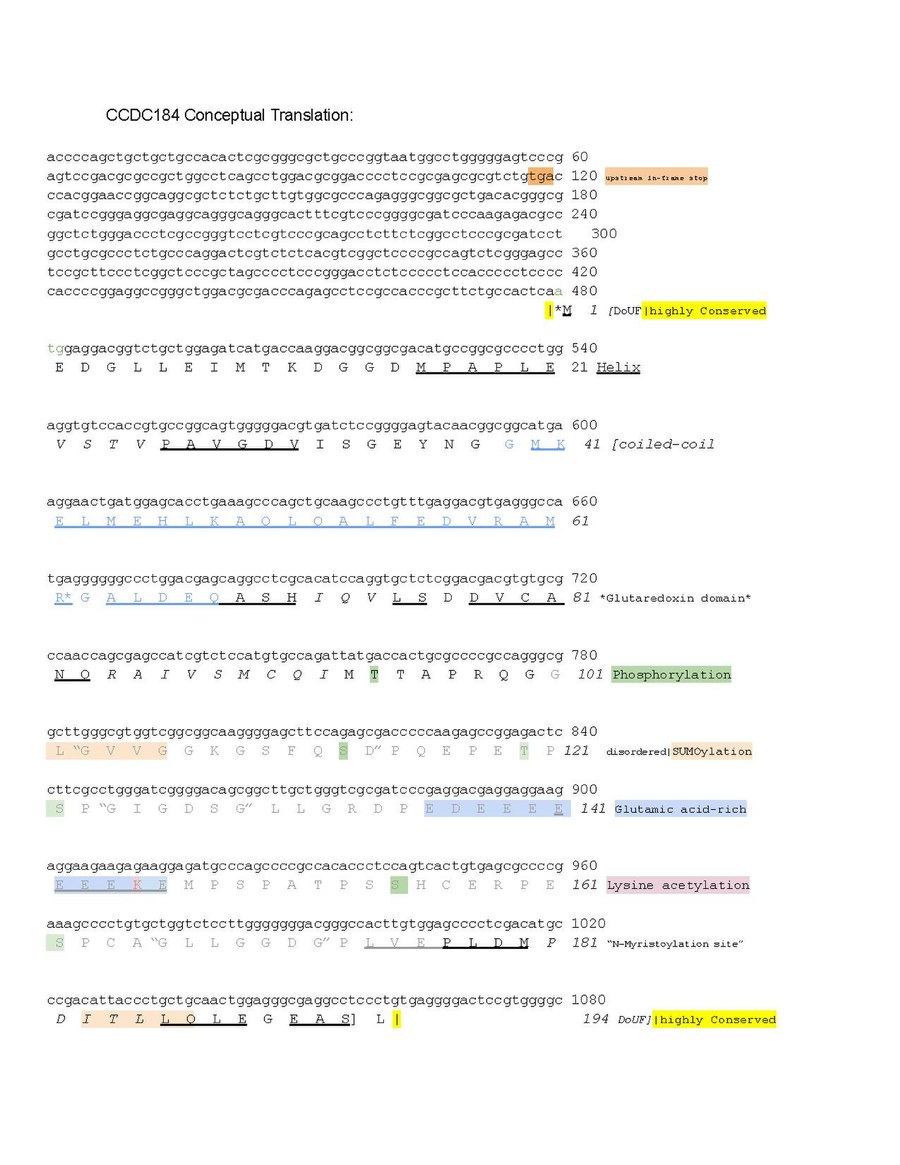CCDC184
| CCDC184 | |||||||||||||||||||||||||||||||||||||||||||||||||||
|---|---|---|---|---|---|---|---|---|---|---|---|---|---|---|---|---|---|---|---|---|---|---|---|---|---|---|---|---|---|---|---|---|---|---|---|---|---|---|---|---|---|---|---|---|---|---|---|---|---|---|---|
| Identifiers | |||||||||||||||||||||||||||||||||||||||||||||||||||
| Aliases | CCDC184, C12orf68, coiled-coil domain containing 184 | ||||||||||||||||||||||||||||||||||||||||||||||||||
| External IDs | MGI: 2146066 HomoloGene: 18612 GeneCards: CCDC184 | ||||||||||||||||||||||||||||||||||||||||||||||||||
| |||||||||||||||||||||||||||||||||||||||||||||||||||
| |||||||||||||||||||||||||||||||||||||||||||||||||||
| |||||||||||||||||||||||||||||||||||||||||||||||||||
| |||||||||||||||||||||||||||||||||||||||||||||||||||
| Wikidata | |||||||||||||||||||||||||||||||||||||||||||||||||||
| |||||||||||||||||||||||||||||||||||||||||||||||||||
Coiled-coil domain-containing 184 (CCDC184) is a protein which, in humans, is encoded by the CCDC184 gene
Gene
Alias for the CCDC184 gene is C12orf68, chromosome 12 open reading frame 68.[5] CCDC184 mRNA sequence, which is 2283 nucleotides in length, and is composed of 1 exon.
Expression
Human CCDC184 is primarily expressed in the components of the brain, such as hypothalamus, pons, pituitary gland.[6] The gene's expression is enhanced and/or over-expressed in the brain tissue expression.[7] Tissue expression cluster predicted Pituitary gland - Hormone signaling[8]
Protein
Overview
CCDC184 Protein is 194 amino acid and contains a domain of unknown function, DUF4677, which spans for 193 amino acid long . CCDC184 protein has a theoretical molecular weight of 20,484[9] dalton and an isoelectric point of 4.04.[10] This indicates the acidic nature of the sequence. The molecular function of the protein is protein binding[11]
Post translational Modification
CCDC184 contains various predicted post-translational modification domains, including phosphorylation, SUMOylation, Glutaredoxin, Myristoylation, Glutamic acid-rich region, and acetylation. The phosphosphorylation sites include S23, T24, and Y36.[12]
| Modification | Amino acid Region |
|---|---|
| Phosphorylation | 76, 113, 155, 120, 122, 162 |
| Myristoylation | 103-108, 109-114, 124-129, 166-172 |
| Glutaredoxin domain | 1-62 |
| Glutamic acid-rich region | 136-146 |
| SUMOylation | 102-106, 183-187 |

P = Phosphorylation site, Sumo: Sumo interacting regions, DUF4677: domain of unknown function
Structure
The human CCDC184 protein is predicted to be localized in the cytoplasm[13]

AlphaFold figure indicates 3D model of CCDC184. The colors indicate the charged regions of the structure
Conceptual translation
The annotated elements shown in the conceptual translation for human CCDC184 protein is post-translational modifications, alpha helices, SUMOylation, Lysine acetylation, domain of unknown function.
Homology
CCDC184 is found only in mammals. 183 organisms that have orthologs with the human gene CCDC184.
Table of Orthologs
Orthologs for CCDC184 are only found in mammals. The most distantly related species to human CCDC184 with a date of divergence of 160 MYA is the opossum. The Tasmanian devil also has a date of divergence of 160 MYA. The table indicates a various selection portion of the mammals' list.
| Taxonomic Order | Genus and Species | Common Name | Accession Number | Sequence Length(aa) | Date of Divergence(MYA) | % Identity to the human protein | % Similarity to the human protein |
|---|---|---|---|---|---|---|---|
| Primate | Homo sapiens | Human | NP_001013657.3 | 194 | 0 | 100 | 100 |
| Primate | Carlito syrichta | Philippine tarsier | XP_008067440.1 | 194 | 69 | 93.3 | 97.4 |
| Scandentina | Tupaia chinensis | Chinese tree shrew | XP_006163517.1 | 85 | 85 | 89.7 | 93.8 |
| Rodentia | Mus musculus | Mouse | NP_808384.2 | 191 | 87 | 90.2 | 82.8 |
| Carnivora | Lontra canadensis | River otter | XP_032732811.1 | 193 | 94 | 93.8 | 96.9 |
| Carnivora | Ursus americanus | American black bear | XP_045656783.1 | 195 | 94 | 94.9 | 96.9 |
| Cetacea | Neophocaena asiaeorientalis asiaeorientalis | Finless porpoise | XP_024592814.1 | 195 | 94 | 92.8 | 95.9 |
| Cetacea | Delphinapterus leucas | Beluga whale | XP_022428046.1 | 195 | 94 | 93.3 | 96.4 |
| Artiodactyla | Camelus ferus | Bactrian camel | XP_006196007.2 | 195 | 94 | 94.9 | 97.4 |
| Artiodactyla | Sus scrofa | Wild boar | XP_020948280.1 | 195 | 94 | 92.8 | 95.4 |
| Chiroptera | Desmodus rotundus | Vampire bat | XP_024431436.1 | 195 | 94 | 90.3 | 93.8 |
| Pilosa | Choloepus didactylus | Two-toed sloth | XP_037701005.1 | 196 | 99 | 88.8 | 92.9 |
| Proboscidea | Elephas maximus indicus | Indian elephant | XP_049738921.1 | 197 | 99 | 89.3 | 94.9 |
| Cingulata | Dasypus novemcinctus | Nine-banded armadillo | XP_004470453.1 | 192 | 99 | 90.2 | 93.3 |
| Marsupial | Gracilinanus agilis | Agile gracile opossum | XP_044534020.1 | 186 | 160 | 72.8 | 80 |
| Marsupial | Sarcophilus harrisii | Tasmanian devil | XP_031793886.1 | 187 | 160 | 69.2 | 77.6 |
 The figure indicates a chart showing the divergence of CCDC184, Cytochrome C and Fibrogen Alpha.
The figure indicates a chart showing the divergence of CCDC184, Cytochrome C and Fibrogen Alpha.
Interaction and clinical significance
Predicted interactions for the CCDC184 gene were seen and the interactions revolved around enabling protein binding activity. Expressions of CCDC184 were connected to studies done on tissue samples for breast cancer somatic mutations[14]
References
- ^ a b c GRCh38: Ensembl release 89: ENSG00000177875 – Ensembl, May 2017
- ^ a b c GRCm38: Ensembl release 89: ENSMUSG00000029875 – Ensembl, May 2017
- ^ "Human PubMed Reference:". National Center for Biotechnology Information, U.S. National Library of Medicine.
- ^ "Mouse PubMed Reference:". National Center for Biotechnology Information, U.S. National Library of Medicine.
- ^ "NCBI Gene". NCBI Gene.
- ^ "Protein Atlas". Human Protein Atlas.
- ^ "Gene Card results for CCDC184". Gene Card.
- ^ "Human Protein Atlas". Human Protein Atlas.
- ^ "PhosphositePlus". PhosphositePlus.
- ^ "Expasy pI tool". ExPasy.
- ^ "PhosphositePlus". PhosphositePlus.
- ^ "PhosphositePlus". PhosphositePlus.
- ^ "PSORT II".
- ^ Mertins P, Mani DR, Ruggles KV, Gillette MA, Clauser KR, Wang P, et al. (June 2016). "Proteogenomics connects somatic mutations to signalling in breast cancer". Nature. 534 (7605). NLM: 55–62. Bibcode:2016Natur.534...55.. doi:10.1038/nature18003. PMC 5102256. PMID 27251275.





